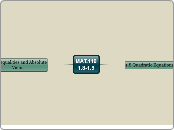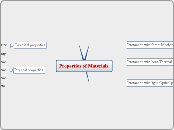Millsaps College Linear Algebra
Final Exam - Spring 2011
Textbook: Linear Algebra and Its Applications
3rd Edition by David C. Lay
Instructor: Dr. Yan Wang
Test 4 (4.2 - 7!)
Orthagonality
Orthogonal Projection
The orthogonal decomposition theorem
Let W be a subspace of R^n. Then each y ∈R^n can be written uniquely in the form y = y-hat + z where y-hat ∈W and z ∈W⊥ In fact, if {u1,...,up} is any orthogonal basis of W, then y-hat = (y·u1/u1·u1)u1+(y·u2/u2·u2)u2+...+(y·up/up·up)up and z = y - y-hat
The vector y-hat ∈ the Orthogonal decomposition theorem is called the orthogonal projection of y onto W and often is written as proj_[w]_y
The length of z, ||z||, is the distance between y and the vector space W.
Given a nonzero vector u ∈ R^n, we can decompose any vector y in R^n as y = y-hat + z where y-hat=αu for some scalar α and z is some vector orthogonal to u. The vector y-hat is called the orthogonal projection of y onto u, and the vector z is called the component of y orthogonal to u.
it can be shown that y-hat = (y·u/u·u)u
Orthogonal Sets
An orthogonal basis for a subspace W of R^n is a basis for W that is also an orthogonal set
Let {u1,...,up} be an orthogonal basis for a subspace W of R^n. For each y in W, the weights in the linear combination y=c1u1+...+cpup are given by cj=y·uj/uj·uj
We can apply the Gram-Schmidt process to produce an orthogonal basis for any nonzero subspace or R^n
A set of vectors {u1,...,up} ∈ R^n is said to be an orthogonal set if each pair of distinct vectors from the set is orthogonal, that is, ui·uj=0 when i is not equal to j
Length, Distance, and Perpendicularity ∈ R^n
If a vector z is orthogonal to every vector in a subspace W of R^n, then z is said to be orthogonal to W. The set of all vectors z that are orthogonal to W is called the orthogonal complement of W and is denoted by W⊥
W=Span{[1,0]}
W⊥=Span{[0,1]}
Two vectors are orthogonal to each other if
||u+v||^2=||u||^2+||v||^2
u·v=0
u^T * v
For u and v ∈ R^n, the distance between u and v, written as dist(u,v) is the length of the vector u-v. ||u-v||
Normalization
A vector whose length is 1 is called a unit vector. Given a vector v, the new vector u=v / ||v|| is a unit vector in the same direction as v
||av||=a||v||
The length or norm of v is the nonnegative scalar ||v|| defined by ||v||=sqrt(v·v) and ||v||^2 = v·v
Let u and v be vectors ∈ R^n with u=[u1,u2,...,un] and v=[v1,v2,...,vn]. Then the inner product (or DOT PRODUCT) of u and v, written u·v is u1v1+u2v2+...+unvn
u·v=(u^T)(v)
Symmetric Matrices
A symmetric matrix is a matrix such that A^T = A. Such a matrix is necessarily square
The Spectral Theorem for Symmetric Matrices
An nxn symmetric matrix has the following properties
A is orthogonally diagonalizable
The eigenspaces are mutually orthogonal
The dimension of the eigenspace for each eigenvalueλ equals the multiplicity of λ as a root of the characteristic equation
A has n real eigenvalues, counting multiplicities
A matrix A is said to be orthogonally diagonalizable if there are an othogonal matrix P (with P^-1 = P^T) and a Diagonalizable matrix D such that A = PDP^T=PDP^-1
An orthogonal matrix is a square matrix U such that U^-1 = U^T. Clearly the set of all column vectors from an orthogonal matrix forms an orthogonal set of unit vectors.
An nxn matrix A is orthogonally diagonalizable if and only if A isa symmetric matrix
If A is symmetric, then any two eigenvectors from different eigenspaces are orthogonal
Eigenvalues
Steps for Diagonalization (the eigen process)
Let A be an nxn matrix.
Find corresponding eigenvectors for eigenvalues of A by solving (A - λI)x=0
The dimension of the eigenspace is equal to the number of free variables in (A -λI)x=0
If the dimension of the eigenspace for each eigenvalue equals the multiplicity of that eigenvalue, then A is Diagonalizable
A=PDP^-1, where P is formed by the Eigenvectors and D is formed by the Eigenvalues corresponding the the eigenvectors
If the dimension of the eigenspace for each eigenvalue is not equal to the multiplicity of that eigenvalue, then A is NOT diagonalizable
All eigenvaectors and the zero vector from an eigenspace for each eigenvalue
Solve det(A - λI)=0 for λ to find all eigenvalues.
Check the algebraic multiplicity
Eigenvectors
Diagonalization Theorem
An nxn matrix is diagonalizable if and only if the sum of the dimensions of the distinct eigenspaces equals n, and this happens if and only if the dimension of the eigenspace for each eigenvalue equals the multiplicity of that eigenvalue
An nxn matrix with n distinct eigenvalues is diagonalizable
A=PDP^-1, with D a diagonal matrix, if and only if the columns of P are n Linearly independent eigenvectors of A. In this case, the diagonal entries of D are eigenvalues of A that correspond , respectively to the eigenvectors in P.
A square matrix is said to be diagonalizable if A is similar to a diagonal matrix, that is, if A=PDP^-1 for some invertible matrix P and some Diagonal matrix D.
An nxn matrix A is diagonalizable if and only if A has n Linearly independent eigenvectors.
If v1, ..., vr are eigenvectors that correspond to distinct eigenvalues λ1, ..., λr of an nxn matrix A, then the set {v1,...,vr} is linearly independent
Let λ be an eigenvalue of a square matrix A. Then the set consisting of the zero vector and all the eigenvectors corresponding to λ iscalled the eigenspace of A corresponding to λ. Note that the eigenspace of A corresponding to λ is Nul (A - λI)
If A is an nxn matrix, then det(A -λI) is a polynomial of degree n in λ, which is called the characteristic polynomial of A. The algebraic multiplicity of an eigenvalue λ is its multiplicity as a root of the characteristic equation.
The eigenvalues of a triangular matrix are the entries on its main diagonal
0 is an eigenvalue of a square matrix A if and only if A is not invertible
The scalar equation det(A - λI) = 0 is called the characteristic equation of A
A scalar λ is an eigenvalue of an nxn matrix A if and only if λ satisfies the characteristic equation det(A - λI)=0
λ is an eigenvalue of A if and only if the equation (A - λI)x=0 has a nontrivial solution
An eigenvalue of an nxn matrix A is a nonzero vector x such that Ax=λx for some scalar λ.. A scalar λ is called an eigenvalue of A if there is a nontrivial solution x of Ax=λx; such an x is called an eigenvector corresponding to λ
An eigenvector must be nonzero, but an eigenvalue may be zero
Dimension of a Vector Space
The Basis Theorem
Let V be a p-dimensional vector space, p at least 1. Any Linearly independent set of exactly p elements in V is automatically a basis for V. Any set of exactly p elements that spans V is automatically a basis for V.
If a vector space V has a basis of n vectors then every basis of V must consist of exactly n vectors
If a vector space V has a basis B = {b1, ..., bn}, then any set in V containing more than n vectors must be linearly dependent
Coordinate Systems
Suppose B={b1, ..., bn} is a basis for V and x is ∈ V. The coordinates of x relative to the basis B (or the B-coordinates of x) are the weights c1, ..., cn such that x=c1b1+...+cnbn.
If c1,..., cn are the B-coordinates of x, then the vector in R^n [x]B = [c1,c2,...,cn] is the coordinate vector of x relative to B, or the B coordinate vector of x.
The mapping x |-> [x]B is the coordinate mapping (determined by B)
Let B = {b1, ..., bn} be a basis for a vector space V. Then the coordinate mapping x |-> [x]B is a one-to-one linear transformation from V onto R^n
The Unique Representation Theorem
Let B = {b1, ..., bn} be a basis for a vector space V. Then for each x ∈ V, there exists a unique set of scalars c1, ..., cn such that x=c1b1+...+cnbn
Basis
Let S be a basis for a vector space V. Then
S is also a Linearly independent set that is as large as possible because adding any vector to S results in a linearly dependent set
Span
S is a spanning set that is as small as possible because deleting any vector from S results in a non-spanning set of V
The pivot columns of A form a basis for Col A
Spanning Set Theorem
vp is a Linear combination of v1,v2,...,v(p-1) if [ v1 v2 ... v(p-1)] x = vp
Span {v1,...,vp}=Span{v1...v(p-1)}
Let S = {v1, ..., vp} be a set in V, and let H = Span {v1, ..., vp}
If one of the vectors in S--say vk--is a linear combination of the remaining vectors in S, then the set formed from S by removing vk still spans H
If H is not {0} (the null set), some subset of S is a basis for H.
Let H be a subspace of a vector space V. An indexed set of vectors B={b1, ..., bp} in V is a BASIS for H if:
the subspace spanned by B coincides with H
H = Span {b1, ..., bp}
B is a Linearly independent set
The range of T is the set of all vectors in W of the form T(x) for some x in V
The Kernel (or NULL SPACE) of a Linear transformation
the set of all u ∈ V such that T(u)=0.
A Linear Transformation T from a vector space V into a vector space W is a rule that assigns to each vector x in V a unique vector T(x) in W such that
T(cu)=cT(u) for all u ∈ V and scalars C
T(u+v) = T(u) + T(v) for all u,v ∈ V
Rank
Rank Theorem
Rank A + dimension Nul A = n
Let A be an mxn matrix. Rank A is equivalent to
Number of Basic Variables in A
The number of pivot positions in matrix A
The Dimension of Col A
Column Space
Col A is the set of all Linear combinations of the columns of A. If A = [a1 a2 ... an], then
dim Col A
number of basic variables in the matrix equation Ax=0
Col A = Span {a1, ..., an}
Null Space
Nul A is the set of all solutions to the homogenous equation Ax=0.
Dimension of Nul A
Number of Free Variables in the matrix equation Ax=0
Nul A = { x : x is ∈ R^n and Ax=0}
Subspace of R^n
The set of all solutions to a system Ax=0 of m homogenous Linear equations in n unknowns is a subspace of R^n
To check if a vector u is in the null space of A, simply solve the equation Au (not a matrix equation, but matrix A times a vector u). If the answer is 0, then u is in Nul A
Related to Eigenspace
Test 3 (2.5 - 4.1)
Vector Subspaces
A subspace of a vector space V is a subset H of V that has three properties
H is closed under multiplication by scalars.
for each u ∈ H and each scalar c, the vector cu is in H
H is closed under vector addition
for each u and v ∈ H, the sum u+v is in H
The zero vector of V is in H
Determinants
A and B are nxn matrices: det AB = (det A)(det B)
if A is an nxn matrix, then det A^T = det A
A square matrix A is invertible if and only if det A is not 0
A is a square matrix and B is the resultant matrix from one row operation
Scalar Multiplication
det(B) = k^(n) det A
interchange
det(B) = -det(A)
Replacement
det(B)=det(A)
Cofactor Expansion
Shortcut
If A is a triangular matrix, then det A is the product of the entries on its main diagonal
The determinant of an nxn matrix can be computed by cofactor expansion across any row or down any column
det A = a11C11+a12C12+...a1nC1n, where Cij = (-1)^(i+j) det Aij
LU Factorization
Row Reduce [L b] to find y.
Row Reduce [ U y ] to find x
Reduce A to an eschelon form U by a sequence of row replacements ONLY is possible.
Place entries in L such that the same sequence of row operations reduces L to I.
Test 2 (1.7 - 2.5)
inverse Matrix
The invertible Matrix Theorem
A Linear Transformation T : R^n -> R^n is said to be invertible if there exists a transformation S : R^n -> R^n such that S(T(x))=x for all x in R^n AND T(S(x))=x for all x in R^n
Let T : R^n -> R^n be a Linear transformation and let A be the standard matrix for T. Then T is invertible if and only if A is an invertible matrix. In that case, the linear transformation S given by S(x)=(A^-1)x is the unique function satisfying the previous conditions
S is the inverse transformation of T, written T^-1
Let A and B be nxn matrices. If AB=I, then A and B are both invertible with A=B^-1 and B=A^-1
A is an invertible, NxN matrix
Let C and D be NxN Matrices
CA=I; AD=I
C=D
A is row equivalent to I
A^T is invertible
(A^-1)^T is its inverse
Columns of A form a Basis for R^n
Rank A = n
Nul A = {0}
dim Nul A = 0
Col A = R^n
dim Col A = n
For all B ∈ R^N, Ax=b has the unique solution x=(A^-1)b
x |-> AX is ONE-TO-ONE
The Columns of A are Linearly Independent
The columns of A do not contain the Zero Vector
det A is not 0
0 is NOT an eigenvalue of A
At Most One Solution
x |-> Ax maps R^N ONTO R^N
A has N pivot columns
The Columns of A Span R^N
b is a Linear combination of the columns of A
N Pivot Positions
At least ONE solution
Algorithm for finding A^-1
Row reduce the augmented matrix [ A I ]. If A is row equivalent to I, then [ A I ] is row equivalent to [ I A^-1]. Otherwise, A does not have an inverse.
The Product of invertible Matrices is Invertible and the inverse is the product of their inverses in the reverse order
(A^T)^-1 = (A^-1)^T
If A and B are nxn invertible matrices, then so is AB, and the inverse of AB is the product of the inverses of A and B in the reverse order. That is, (AB)^-1 = (B^-1)(A^-1)
If A is an invertible matrix, then A^-1 is invertible and (A^-1)^-1 = A
Theorem 4 (2.2)
If A is an invertible nxn matrix, then for each b in R^n, the equation Ax=b has the unique solution x = (A^-1)b
2x2 inverse
A^-1 = (1/ad-bc) [d -b, -c a]
ad-bc = det A, which is the Determinant of A
Let A = [a b, c d]. If ad-bc is not equal to 0, then A is invertible
An nxn matrix A is said to be invertible is there is an nxn matrix C such that CA=I and AC=I, where I is the nxn identity matrix. C=A^-1 (A inverse)
Non-singular Matrix
invertible Matrix
Singular Matrix
NOT invertible
Transpose Matrix
Properties
(AB)^T = (B^T)(A^T)
for any scalar r, (rA)^T = rA^T
(A+B)^T = A^T + B^T
(A^T)^T=A
The transpose of an mxn matrix is denoted A^T and changes A's rows for its columns
A is mxn, A^T is nxm
Matrix Operations
WARNINGS
If AB=0, you cannot conclude that A=0 or B=0
If B=C, AB is not always equal to AC
AB is not always equal to BA
IA=A=AI
r(AB)=r(A)B=A(rB) for any scalar r
(B+C)A=BA+CA
A(B+C)=AB+AC
A(BC)=(AB)C
Linear Transformation
The Matrix of a Linear Transformation
Assuming that T : R^n -> R^m is a linear transformation, there exists a unique matrix A, such that T(x)=Ax for all x in R^n
A is the mxn matrix whose jth column is the vector T(ej)
The Standard matrix for the Linear transformation T
A = [ T(e1) ... T(ej) ]
Identity Matrix
ej is the jth column of the identity matrix ∈ R^n for 1
has 1's on the diagonal and zeros elsewhere
nxn matrix denoted I
Existence and Uniqueness Questions
ONE-TO-ONE
The columns of a matrix A are Linearly independent
T(x)=0 has ONLY the trivial solution
A mapping T : R^n -> R^m is said to be one-to-one if each b in R^m is the image of at MOST one x in R^n
T(x1) is not equivalent to T(x2) when x1 is not equivalent to x2
ONTO
Columns of a matrix A span R^m
A mapping T : R^n -> R^m is said to be onto R^m if each b in R^m is the image of at LEAST one x in R^n
A transformation (or mapping) T is linear if:
All Matrix transformations are Linear transformations
T(0)=0
T(cu+dv)=cT(u)+dT(v) for all vectors u,v and scalars c,d
T(cu)=cT(v) for all u and scalars c
T(u+v)=T(u)+T(v) for all u,v ∈ the domain of T
A transformation (or function or mapping) T from R^n to R^m, denoted by T : R^n -> R^m, is a rule that assigns to each vector x in R^n a vector T(x) in R^m.
For x ∈ R^n, the vector T(x) in R^m is called the image of x (under the action of T). The set of all images T(x) is called the range of T
The set R^m
The CODOMAIN of T
The set R^n
DOMAIN of T
Linear Dependence
A set that contains more vectors than entries in each vector
A is an mxn matrix
n > m
S={v1, ..., vp}
Set contains the zero vector
there exists at least one vector in S that is a linear combination of the others
Set of TWO vectors
Scalar multiples
The set {v1, ..., vp} is said to be Linearly dependent if there exists weights c1, ..., cp not all zero, such that c1v1+c2v2+...+cpvp=0.
Linear Independence
{v1, ..., vp} does NOT contain the zero vector
Ax=0 has only the trivial solution
An indexed set of vectors {v1, ..., vp} in R^n is said to be linearly independent if the vector equation x1v1+x2v2+...+xpvp=0 has ONLY the trivial solution
Test 1 (1.1 - 1.6)
Theorem 5 (1.4)
About COEFFICIENT matrices
Let A be an mxn matrix. The following are logically equivalent
A has a pivot position in every row
The columns of A span R^m
Each b ∈ R^m is a linear combination of the columns of A
For each b ∈ R^m, the equation Ax=b has a solution
Existence and Uniqueness Theorem
A Linear system is consistent if and only if the rightmost column of the augmented matrix is NOT a pivot column--that is, if and only if an eschelon form of the augmented matrix had no row of the form [0 0 0 ... 0 b], with b nonzero
If a Linear system is consistent then the solution set contains either
infinitely many solutions
at least one free variable
a unique solution
no free variables
Definitions
Homogenous System
For a given equation Ax=0, a nontrivial solution is a nonzero vector x that satisfies Ax=0
Happens when there is at least one free variable
Parametric Vector Form
The zero solution of Ax=0 is called the trivial solution.
A Linear system is homogenous if it can be written in the form Ax=0, where A is an mxn matrix and 0 is the zero vector in R^m.
Span of Vectors
The collection of all vectors that can be written in the form c1v1+c2v2+...+cpvp with c1, ..., cp scalars
Linear Combination of Vectors
Given the vectors v1, v2, v3, ..., vp ∈ R^n and given scalars c1,c2, ..., cp in R, the vector y defined by y=c1v1+c2v2+...+cpvp is called a linear combination of v1, v2, ..., vp with weights c1, c2, ..., cp
Free Variable
Variable not corresponding to a pivot column
Basic Variable
Variable corresponding to a pivot column
Pivot Column
Column of A containing a pivot position
a location in A that corresponds to a leading 1 in the reduced echelon form of A
echelon Form
Reduced echelon Form
Unique Row Reduced Matrix for each Eschelon matrix
Each leading 1 is the only nonzero entry in its column
The leading entry of each nonzero row is one
each leading entry of a row is in a column to the right of the leading entry of the row above it
all entries in a column below a leading entry are zeros
All nonzero rows are above any rows of all zeros
Consistent Linear System
One or more solution









